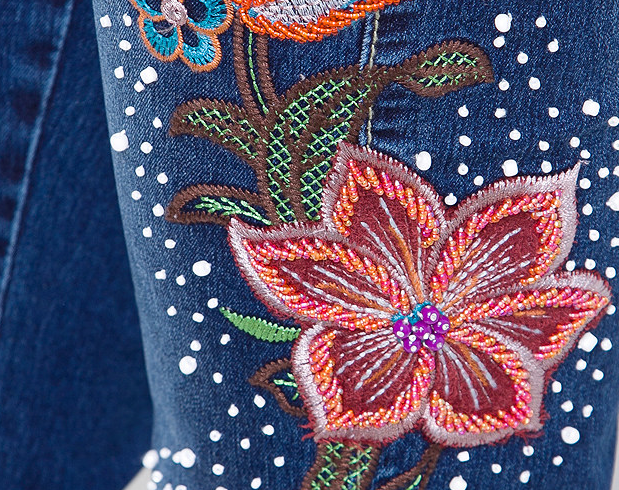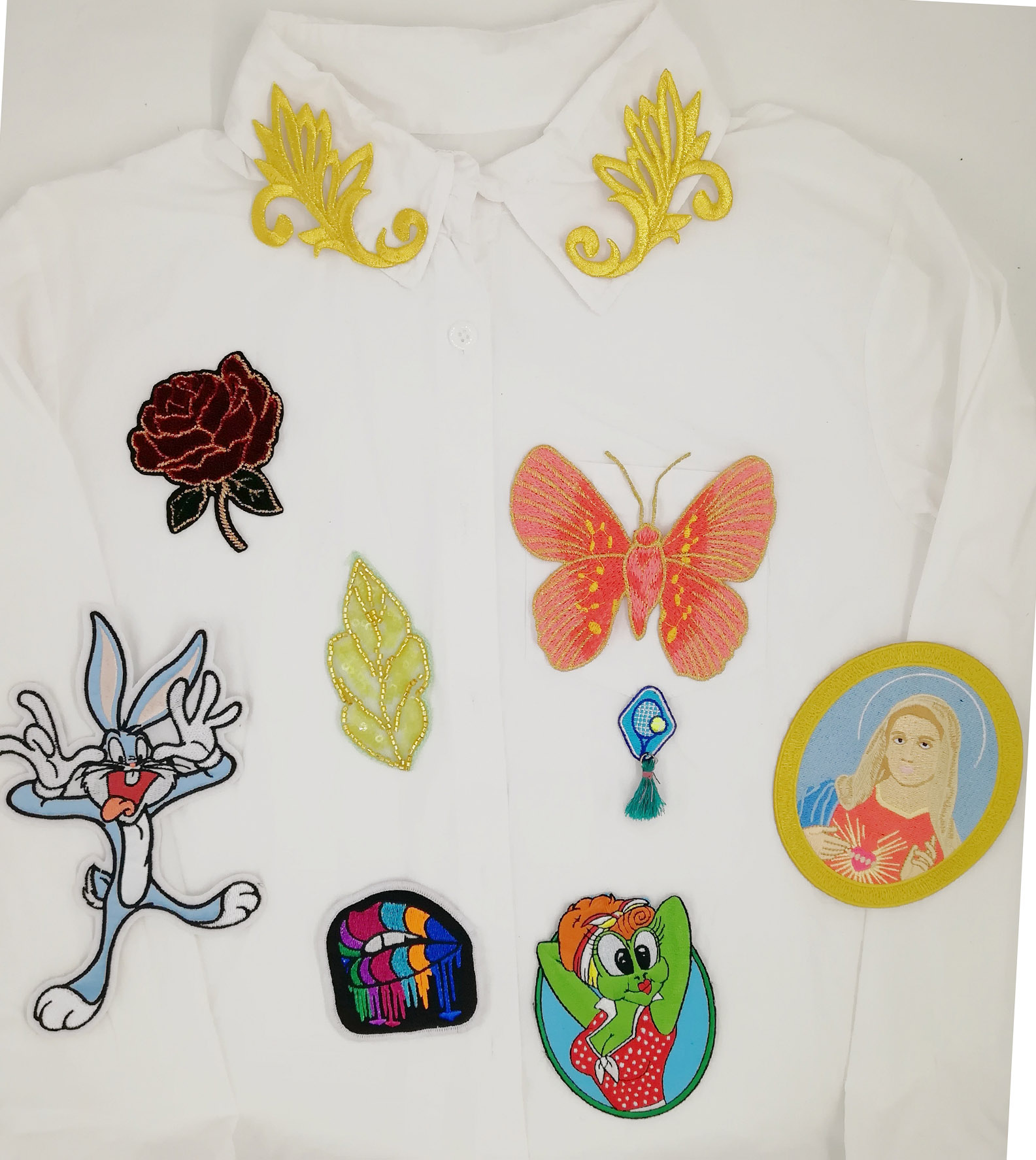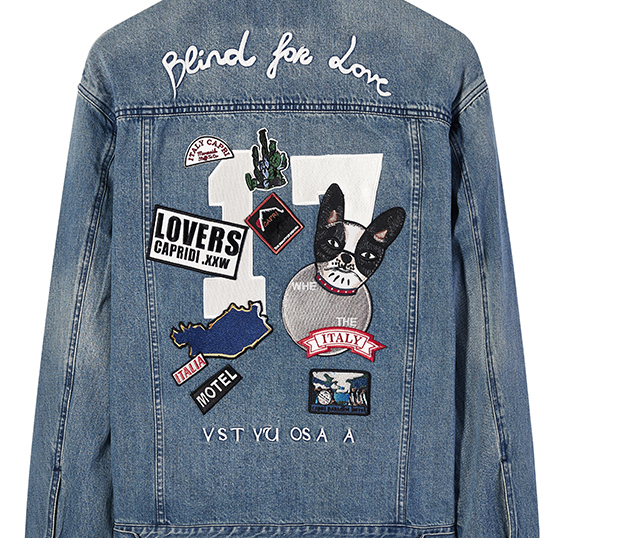The protein protein solution is extracted from soybean meal protein, and the soybean protein fiber obtained by wet spinning after chemical treatment maintains the excellent hygroscopicity of natural fiber cotton, the smoothness of cashmere and the elegant luster of silk, and becomes a new textile fiber. , a new high-grade fabric that is knitted or knitted into different styles. By finishing technology after printing and dyeing, retains all the features of soybean protein fiber, get the look luxurious, bright color, sense of color and soft, good elasticity, comfort is good, with the health effects of functional textile products.
Iron on Patches Description:
Size:Different size as customer`s request
Embroidered Area:30%,50%,75%,100%
Background:Twill,Felt,Velvet,Reflective background
Color:9 standard colors are available at free charge,One additional color will need to add cost
Border:Merrow border,die cut border,heat cut border and laser cut border
Backing:No backing/ironon backing/self-adhesive/paper coating/loop&hook
MOQ:100PCS
Delivery term:UPS/DHL/FEDEX/TNT/EMS/AIRMAIL or by air/by sea
Fashing Production:
How to useful?
Embroidery Patch,Iron On Appliques,Custom Embroidered Patches,Beaded Embroidery Patch DONGGUAN SHITAI ACCESSORY TEXTILES CO.,LTD , http://www.stsewingcraft.com
In this paper, by analyzing the influence of the structural properties of soy protein fiber on the dyeing properties, it is discussed that those dyes at this stage are suitable for dyeing. The soy protein fiber has a flat dumbbell shape or a rounded cross section, and the longitudinal surface is grooved. Under the electron microscope, it can be observed that the longitudinal surface of the soybean fiber is a shuttle-shaped stripe with a length of about 3-4 μm, a width and a depth of about 0.1 μm, and a potential fibril structure can be observed, so it is easy to lightly after taking the friction. velvet. Under the optical microscope, it has a distinct sheath-core structure. The cortical structure is compact and tough, and the core layer forms a plurality of sponge-like porous structures when solvent is removed from the coagulation bath. Its molecular structure has a variety of polar groups, such as hydroxyl groups, acetal groups, amino groups, etc., these groups have different color absorption properties. Among them, the hydroxyl group is hydrophilic, and has similar dyeing properties to cellulose fibers. It can be dyed by direct, active, sulfuric acid, etc., but its reaction ability is weak, so it is not dyed with other cellulose fibers. . The acetal group is a hydrophobic group, which can be selected by dispersing and neutral complex dyeing; the amino group can also be dyed with an acid dye. In fact, due to the special structure of the soy protein fiber, it shows the dyeing property between the cellulose fiber and the chemical fiber, and has good acid and alkali stability, and the dye range suitable for dyeing is wide.
1 Dye selection for soy protein fiber dyeing
1.1 dyes for cellulose fibers
1.1.1 Direct dyes
Direct dyes are mainly suitable for dyeing cellulose fibers and for dyeing protein fibers. Soy protein fiber is composed of polyvinyl alcohol and soy protein. Since a certain amount of a polymer having a polar group such as a hydroxyl group or a cyano group has been added to the soybean protein fiber, the direct dye has a high directness, and the dyeing test indicates that the dyeing rate and the balance are dyed. The rate is significantly higher than silk and wool, but the color yield is not as good as cellulose fiber.
However, the soy protein fiber is dyed with direct dye, the gloss is dim, the color fastness is poor and the washing fastness is poor. It needs to fix the color and affect the hand feeling. The color yield is not as good as other cellulose fibers, except for the individual hue, it is generally not suitable. Therefore, the direct dye is not the primary dye.
1.1.2 Reactive dyes
There are two ways to combine reactive dyes with soy protein fibers: one is covalently bound to the active amino acid of soy protein, and the other is covalently bonded to the residual hydroxyl group of the polyvinyl alcohol component, and the former is the main one. The advantage of reactive dyeing is that the color is bright and the washing fastness is good when dyeing light color. However, the reactive dyes may have different dyeing properties for soy protein fibers due to differences in the parent structure, active groups, and bridging groups (linking groups), so not all reactive dyes are suitable for soy protein fiber dyeing.
Cibacron LS, Megafix B and Remazol dyes have higher fixation and fixation efficiency for soy protein fiber, and are more suitable for soy protein fiber dyeing. Lanasol reactive dyes for wool are not suitable for soy protein fiber dyeing. In addition, it should be noted that Realan wool and silk special reactive dyes have low dyeing depth on soybean fiber under weak acidity and high temperature conditions, and dyeing properties of soybean fiber under 50% and alkaline conditions are acceptable, but not Recommended.
There is a big difference in the performance of various reactive dyes, and there are also differences among different varieties of the same dye. Overall, Cibaeron LS dyes have the best performance, followed by Megafix B dyes. The advantages and disadvantages of commonly used reactive dyes are as follows:
(1) Domestic KE type dye: It can dye light color and partial medium color. The dyeing process is simple. The color fastness of high temperature dyeing process can also meet the requirements, but the dyeing rate is low, the wastewater discharge is large, and the dye cost is economical.
(2) Megafix BES type dye: It is a kind of highly reactive mixed reactive dye with mono-chlorotriazine and vinyl sulfone double groups. These two reactive groups have good complementarity in soybean fiber dyeing. With synergistic effect, leveling and translucency are good, brightness, vividness is excellent, easy to wash, in addition to individual dark shades, can achieve good color fastness.
(3) Cibacron LS NHC type dye: it is a reactive dye of bischlorotriazine active group, has good solubility, low neutral salt dosage, suitable for general medium, light and partial dark dyeing, brightness, vivid The degree is very good, the dye cost is higher than the BES type dye.
1.1.3 Acidic and neutral dyes
(1) weak acid dye
The order of dyeing weak acid dyes on protein fibers from deep to light is: cashmere > wool > silk > soy protein fiber. Soy protein fiber has the lowest dye uptake, which is related to the polar amino acid content of the fiber. The polar amino acid content (%) of the three protein fibers is compared as follows:
1 hydroxy amino acid: silk (28.01) > wool (21.45) > soy protein fiber (12.64);
2 basic amino acids: wool (35.27) > soy fiber (3.50) > silk (1.67);
3 acidic amino acids: wool (21.06) > soy fiber (8.0) > silk (3.47).
When the weak acid dye is dyed under acidic conditions, the dye uptake rate is related to the content of basic amino acids and hydroxy amino acids (mainly tyrosine) in the protein fiber. The total amount of these two kinds of amino acids in the soy protein fiber is much smaller than that of wool and silk. Therefore, the color yield is the lowest and the relative depth is the shallowest. In addition, the dye uptake rate is also related to factors such as the higher molecular orientation of soy protein fiber.
The acid dye has uniform dyeing, good hiding property and excellent transmissibility. The gloss and brightness after dyeing are basically close to the reactive dye, and the dyeing process is simple, the hand feel is soft, the color yield is high, and the dyeing liquid has high exhaustion rate and dyeing residue. Clear, low wastewater discharge and other advantages, become a common dye for soy protein fiber, but the cost of dyes is higher.
(2) Neutral complex dye
Neutral dyes have similar dyeing properties to direct dyes, but due to their larger molecules, poor permeability and hiding power, it is necessary to improve the dyeing process conditions to improve the hiding power. The color yield is basically the same as that of weak acid dyes, and the gloss and feel are only second. For reactive dyes and weak acid dyes, the color fastness is good, but the dye cost is high and the washing fastness is poor.
(3) Lanatet dye
Since the Lanaset dye is a modified neutral and active complex dye, it is more suitable for soy protein fiber dyeing with multi-group properties. It has excellent leveling and translucent dyeing effect, and the wastewater discharge is small, but the dyeing depth and dyeing vividness are much worse than that of dyed wool fabric, and the color fastness to washing is poor, and the dye cost is high. Soy protein fabrics have deep, bright, and strong dyeing effects, and the dyeing process remains to be further studied. Usually in dyeing production, most of the medium and light colors are dyed with economical reactive dyes, and only the individual colors such as deep rose, deep purple, black, etc. are selected.
1.1.4 Disperse dyes
Disperse dyes can also be dyed on soy protein fibers. Disperse dyes dye soybean protein fiber more deeply than wool and cashmere, but the dye fastness of disperse dye on soy protein fiber and its distribution in the fiber still need to be tested. Disperse dyes have a certain affinity for protein fibers, some dyes can also be dyed deep, and soy protein solutions can be chemically modified before spinning to increase the affinity for disperse dyes.
Therefore, the soy protein fiber has a certain dyeability to a high-temperature disperse dye containing a large amount of a hydroxyl group or an amino group. It is known that the disperse dyes have improved performance on soy protein fibers. The azo disperse dyes with two hydroxyl groups (such as Diacelliton Ruby 3B and Terasil Brown 3R) have better hydrogen bond interaction with soy protein fibers. Dyeing performance. Disperse blue 2BLN with two hydroxyl groups and two amino fluorene structures and a dispersed orange E-GFL with one hydroxyl group and one methoxybisazo structure are also better in darkness, while other dyes, whether azobenzene or not. And azo heterocycles, or dyes of ruthenium structure, have poor dyeing properties.
2 Conclusions <br> Soy protein fiber can be dyed with direct, acidic, active, neutral and disperse dyes. The selected dyes have a certain dyeing capacity for soy protein fiber. Among them, direct dyes and acid dyes have high dye uptake rate, are suitable for dyeing dark varieties, and have poor dyeing fastness, and need to be fixed by color. Reactive dyes and disperse dyes have low dye uptake and good dye fastness, suitable for dyeing medium and light colors. The reactive dye should be selected from the type of double reactive group to increase the fixation rate. For disperse dyes, high-temperature dyes with large molecular structures and many polar groups should be selected. Neutral dyes have good dye transfer performance on soy protein fiber, and can improve the dyeing uniformity by high temperature transfer and prolonging the dyeing time. The selection of neutral dyes and disperse dyes and process conditions are for further discussion. 



